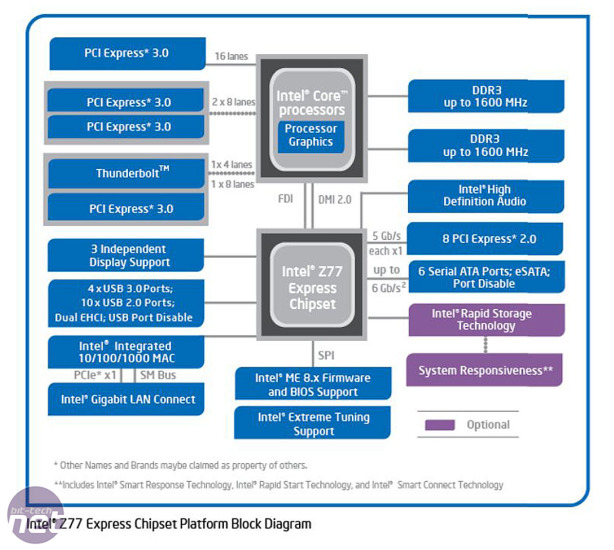
The Z77 Chipset
As well as the new range of Ivy Bridge CPUs, Intel has also released (three weeks ago) its range of Panther Point 7-series chipsets, at the top end of which is Z77. Backwards compatible with Sandy Bridge CPUs (albeit with some key features disabled), Z77 is a minor update to its predecessor, the Z68 chipset, but with some notable new additions.For enthusiasts, the most important of these will be the introduction of PCI-Express 3.0 and native support for USB 3.0. As the PCI-E 3.0 bus runs directly to the CPU rather than the chipset, you’ll need a compatible Ivy Bridge processor to enable it, although the benefit of this to 3D performance is likely to be negligible (GPGPU performance however should benefit).
There are up to four native USB 3.0 ports, while SATA connectivity is unchanged, with a pair of SATA 6Gbps ports and a quartet of SATA 3Gbps ports. Many board partners will compliment this with either AS Media or JMicron SATA 6Gbps ports, but our experience has found these pale in comparison to the performance of Intel’s native SATA 6Gbps ports.
Click to enlarge - the Z77 chipset block diagram
DDR3 memory support has been significantly improved, and while the chipset still uses dual-channel DDR3, memory of up to 1,600MHz is now officially supported. Memory frequency granularity has also been improved to now cover 200/266MHz, with a maximum supported memory frequency of 2,667MHz.
With the addition of an Ivy Bridge CPU featuring Intel HD 4000 graphics, Z77 also supports up to three independent displays (two digital, one VGA). This isn’t Intel-finity though, and won’t support single large resolutions.
Making its return in Z77 is Intel’s Smart Response SSD caching technology. This allows you to combine an SSD and a hard disk drive, with the system using the SSD as a high-speed cache for your most frequently used data and programs. The setup process for this has been significantly streamlined too, making it much easier to setup. For those who don’t want this feature, the Z75 chipset is otherwise identical, but lacks Smart Response.
Click to enlarge - We'll be reviewing Z77 motherboards such as the Gigabyte Z77X-UD5H shortly
Lastly, switchable graphics return, care of Lucid Virtue. Its two new technologies, Hyperformance and Virtual Vysnc, see the software (which isn’t exclusive to Intel’s platform) use the Intel HD 4000 graphics as a frame buffer for the GPU, while also further manipulating performance by tagging redundant frames (i.e. those above the monitor’s refresh rate) as rendered, despite not having actually rendered them.
The result is effectively spoofed GPU performance, and frame rate increases of an unlikely 200% (or more), even from £400 GPUs such as the GeForce GTX 680 2GB. While the power benefits of Lucid Virtue are helpful, we are enormously sceptical of this frame rate manipulation technology and we’re not the only one. 3DMark has already moved to enable Lucid Virtu detection to stop misleading results being uploaded.
We’ll be looking at all of the Z77 specific features in a follow-up article, but it certainly seems a capable platform on which every major motherboard company is basing its 7-series product lines.

MSI MPG Velox 100R Chassis Review
October 14 2021 | 15:04










Want to comment? Please log in.